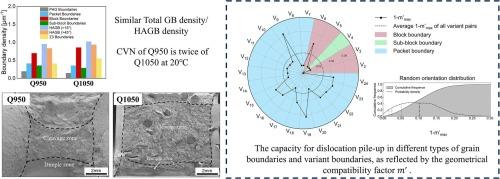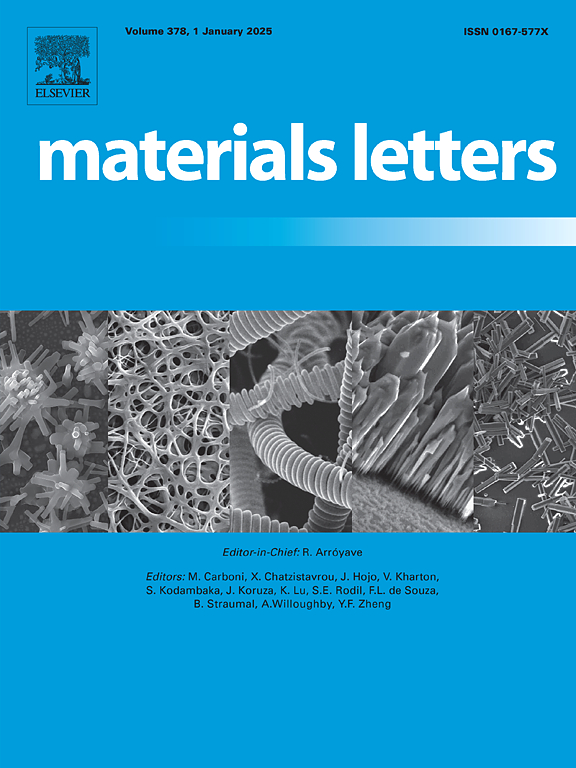探索贝氏体钢中不同类型高角度晶界对韧性贡献的变化
IF 2.7
4区 材料科学
Q3 MATERIALS SCIENCE, MULTIDISCIPLINARY
引用次数: 0
摘要
一般来说,钢的韧性在很大程度上受高角度晶界(HAGB)密度的影响。然而,在贝氏体钢中,各种类型的晶界都可能表现出高角度,这可能导致它们对韧性的贡献不同。在这项研究中,两种化学成分相同、强度和伸长率相似、HAGBs 密度相当的钢材样品在 20 °C 和 -40 °C 下进行的夏比冲击试验中表现出不同的吸收能。晶体学分析表明,虽然两种样品的 HAGBs 密度相似,但与块状边界相比,先奥氏体边界和包状边界通过增强塑性对冲击吸收能量的贡献更大。由于块体边界中 V1/V2 变体边界的比例较高,这种差异尤为明显。这些发现强调了了解不同 HAGB 类型对贝氏体钢韧性的细微贡献的重要性。本文章由计算机程序翻译,如有差异,请以英文原文为准。

Exploring variations in toughness contributions across different types of high-angle grain boundaries in bainitic steels
Generally, the toughness of steel is greatly influenced by the density of high-angle grain boundaries (HAGBs). However, in bainitic steel, various types of boundaries can exhibit high angles, potentially leading to differences in their contributions to toughness. In this research, two steel samples with same chemical composition, similar strength and elongation, and comparable HAGBs densities demonstrated varying absorption energies in Charpy impact tests conducted at 20 °C and −40 °C. Crystallographic analysis revealed that although both samples have similar density of HAGBs, prior austenite boundaries and packet boundaries contribute more to impact absorption energy by enhancing plasticity compared to block boundaries. The discrepancy was particularly notable due to the high proportion of V1/V2 variant boundaries within the block boundaries. The findings underscore the significance of understanding the nuanced contributions of different HAGB types to the toughness of bainitic steels.
求助全文
通过发布文献求助,成功后即可免费获取论文全文。
去求助
来源期刊

Materials Letters
工程技术-材料科学:综合
CiteScore
5.60
自引率
3.30%
发文量
1948
审稿时长
50 days
期刊介绍:
Materials Letters has an open access mirror journal Materials Letters: X, sharing the same aims and scope, editorial team, submission system and rigorous peer review.
Materials Letters is dedicated to publishing novel, cutting edge reports of broad interest to the materials community. The journal provides a forum for materials scientists and engineers, physicists, and chemists to rapidly communicate on the most important topics in the field of materials.
Contributions include, but are not limited to, a variety of topics such as:
• Materials - Metals and alloys, amorphous solids, ceramics, composites, polymers, semiconductors
• Applications - Structural, opto-electronic, magnetic, medical, MEMS, sensors, smart
• Characterization - Analytical, microscopy, scanning probes, nanoscopic, optical, electrical, magnetic, acoustic, spectroscopic, diffraction
• Novel Materials - Micro and nanostructures (nanowires, nanotubes, nanoparticles), nanocomposites, thin films, superlattices, quantum dots.
• Processing - Crystal growth, thin film processing, sol-gel processing, mechanical processing, assembly, nanocrystalline processing.
• Properties - Mechanical, magnetic, optical, electrical, ferroelectric, thermal, interfacial, transport, thermodynamic
• Synthesis - Quenching, solid state, solidification, solution synthesis, vapor deposition, high pressure, explosive
 求助内容:
求助内容: 应助结果提醒方式:
应助结果提醒方式:


